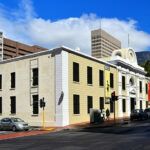Slave Lodge museum
The arrival of the Dutch ship Amersfoort in March 1652, carrying 174 enslaved people, marked Cape Town’s entry into the global slave trade. A letter from Jan van Riebeeck in 1654 requested more enslaved labour to be sent from Madagascar. This began a dark chapter to sustain the development of the settlement at minimal expense.
The slaves were initially housed in the Fort. In 1658 a lodge called Corenhoop (meaning maize heap/grain store) was completed as part of the Fort’s outbuildings and 98 slaves moved into this lodge on 29 May of that year.
The early Slave Lodge in Cape Town went through several changes before becoming the structure we know today. By 1669, the original lodge had fallen into disrepair, necessitating reconstruction. Despite these efforts, space soon became inadequate, with some slaves temporarily housed in the Castle. Under Commander Isbrand Goske (1672-1676) and later Johan Bax (1676-1678). Discussions led to the Council of Policy approving a new lodge’s construction on February 22, 1679, beside the existing one near the Company Gardens. By July 28, 1679, slaves housed in the Castle moved into the new building. After the old lodge burned down on August 19, all Company slaves were housed in the new structure.
As the population grew, the lodge was expanded in 1679 and later in 1752, when a second story was added. The building, designed to hold up to 1,000 people, had dark, windowless rooms arranged around a central courtyard for roll calls and cooking. The building was expanded in 1752 when it gained a second story. Records show that the Slave Lodge was altered at least seven times.
During work on the building in the 1960s, a pit was excavated in the courtyard. The use of which is uncertain. It was possibly a well, but it was more likely used for underground water storage. There are two sections to it, one underneath the other, separated by a paved floor. Artefacts unearthed were fragments of bowls and other ceramic objects, several coins, and bone fragments 11 species of animal bones were identified and were mainly the bones of sheep, cattle, fowls and pigs, as well as many fish bones and ostrich eggshell fragments. Many disused bricks, nails, window glass and roof tiles were also found in the excavation trenches, as well as charcoal, firebricks and wood.
The excavation also revealed slave cellars, stone and brick walls, cobbled floors, well, old doorways and steps leading into the courtyard and a corner where the latrines were situated.
After the British annexation in 1806, the lodge was transformed into government offices. The facade of the building as it is seen today was designed by Louis Thibault and Anton Anreith. In 1966, it was reopened as the SA Cultural History Museum but later renamed the Slave Lodge in 1998. It is now part of the Iziko Museums network. The building preserves its complex history that is reflected in its many names: Slave Lodge, Government Offices Building, Old Supreme Court, and SA Cultural History Museum.
Entrance included on your City Pass ticket
c/o Wale and Adderley Streets, Cape Town


